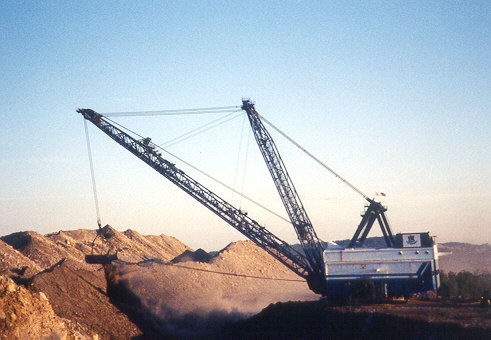
|
|
|
|
|
|
|
|
|
|
|
Surface Mining

Once known as "strip" mining, this method of mining involves removing the overburden with heavy earth moving equipment, scooping out the coal, replacing the excavated soil and reestablishing vegetation and plant life, a process known as reclamation.
As a method of coal extraction, surface mining
accounts for about 60% of total U.S. coal production of over 1 billion tons
annually. It permits recovery of as much as 95% of the deposit due to the
accessibility of the coal and the efficiency of massive high-tech equipment.
At any given time, a large surface mine
particularly in the western U.S. can be three miles long and a mile wide. The mine is always on the move with
coal extraction activities going on in one area and reclamation in another.
Draglines are a key element in the high
productivity of modern surface mines. They are large excavating machines used to
remove the overburden or layers of earth, rock and other material covering a
coal seam. The dragline has a large bucket, suspended from the end of a huge
boom, which may be as long as 300 feet. The bucket which is suspended by cables
is able to scoop up great amounts of overburden as it is dragged across the
excavation area. Some buckets have capacities of up 250 tons. The dragline,
which can walk on huge pontoon like feet, is one of the largest land based
machines in the world.
Aside from their uses on relatively flat or
rolling terrain, draglines are now being employed to reach important coal
deposits in more mountainous regions. On the steep slopes of central Appalachia
for example, draglines are making possible the efficient recovery of low sulfur
coal deposits. In such settings, draglines can greatly reduce the costs and
improve the efficiency of overburden removal.
Among other equipment which has made surface
mining the most productive method of coal extraction are electric power shovels
which are used to remove overburden and load coal; huge bucket wheel excavators,
also employed in the overburden removal process; trucks, which haul both rock
and coal from the mine site and sophisticated covered conveyor systems, which
deliver coal to nearby preparation plants and eventually on to the customer.
High tech advances in metallurgy, engines and electric motors have made possible
development of these large and sophisticated machines.
Computer assisted machinery allows more
autonomous mining. These include guidance systems for navigation; onboard
computers to self diagnose maintenance problems; intelligent signal processing
for coal interface detection; natural language processing and computer graphics
for worker machine interaction; as well as automated technology for other mining
functions.
The surface coal mining industry is guided by
one major principal: the right of coal extraction carries with it the
responsibility of restoring the land to its original or better condition. To
assist in this effort, some companies utilize computer aided reclamation design
to develop exact profiles on the site and monitor progress. In addition, aerial
photography can be employed to document the success of ongoing reclamation
efforts.
Surface mining is as much a land reclamation process as it is a way of extracting coal. Ultimately reclaimed sites are returned to many productive uses such as recreation areas, golf courses, wildlife preserves, parks, farms, wetlands, housing developments and pastures.
| Coal Leader, Inc. | |
| Mailing: P.O. Box 858 Richlands, VA 24641-0858 |
Shipping: 222 Sunny Hills Dr. Cedar Bluff, VA 24609-1715 |
| Phone: 276-964-6363 | Fax: 276-964-6342 |
|
Coal Leader |
|
| Barbara F. Altizer | |
| Marty Snyder | |
| Robert Fields | |